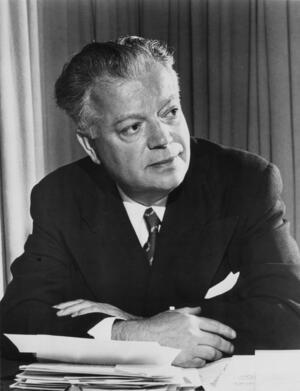David Dubinsky
A black and white photograph of David Dubinsky (1892 - 1982) sitting at a desk.
Photo ID: 5780PB7F5C. Estimated date: 1934. International Ladies Garment Workers Union Photographs. Kheel Center Flickr Photostream.
David Dubinsky (born Dobnievski) was born in 1892 in what is now Belarus, the youngest of eight children in a religious family. His family moved to Lodz, Poland, when he was a small child. His father owned a bakery, and in early childhood David began working there, eventually leaving school to work full time. He joined the bakers’ union, and by age 15 had become a union leader.
In 1907, David was arrested for his union activities and jailed for three days. The following year, he was arrested again and this time held for 18 months and then sentenced to exile in Siberia. On the way to Siberia, he escaped, eventually making his way to New York City in 1911, where he joined a brother. Through his brother, he got a job as a cutter (one of the most skilled jobs in the garment industry) and joined Local 10 of the International Ladies’ Garment Workers’ Union (ILGWU) and the Socialist Party.
Dubinsky rose quickly in the union ranks. In 1918, he was elected to the local’s executive board, becoming vice-president the following year and president in 1921. He also became general manager, a full-time paid position that enabled him to leave his job on the cutting floor. As a union leader, he fought to remove Communist Party members from leadership positions—a bitter fight that he won but at great cost to the union’s strength.
David—or D.D., as he was called in the union—also became a leader in the national ILGWU, joining its executive board in 1922. He became the Secretary-Treasurer in 1929 and then also its President in 1932, holding these positions until 1959 and 1966, respectively. The union grew under his leadership and with the help of Roosevelt’s New Deal programs such as the National Industrial Recovery Act and the National Labor Relations Board, reaching more than 450,000 members in 1957. Dubinsky helped expand worker benefits as well as cultural and leisure opportunities. While more than three quarters of the union’s members were women, the leadership remained almost exclusively male—a problem about which Rose Pesotta, a leading ILGWU organizer and the lone female member of its executive board, complained to Dubinsky.
Dubinsky also worked to expand union organizing of the other mass production industries. He joined with John Lewis of the United Mine Workers to found the Committee for Industrial Organization (CIO) in 1935, and took the ILGWU out of the American Federation of Labor (AFL) when it banned all unions affiliated with the CIO. But when Lewis and Sidney Hillman of the Amalgamated Clothing Workers decided to split from the AFL to create the independent Congress of Industrial Organizations, Dubinsky did not follow them. In 1940, he reaffiliated the ILGWU with the AFL and five years later was re-elected to its executive council. Within the AFL, he worked to fight against corruption in the union.
Dubinsky also helped create political parties that would support workers and unions. In 1936, he and Sidney Hillman of the Amalgamated Clothing Workers helped found the American Labor Party to help organize progressives to vote for Democratic candidates. Dubinsky left the Labor Party in 1944 over the involvement of Communist Party members, and went on to create the Liberal Party of New York.
Dubinsky retired from the AFL-CIO in 1966, and died in 1982 at age 90.
Sources:
Book Rags. “Encyclopedia of World Biography on David Dubinsky.” Accessed April 10, 2012. http://www.bookrags.com/biography/david-dubinsky/.
The Franklin and Eleanor Roosevelt Institute. “David Dubinsky.” Accessed April 10, 2012. http://newdeal.feri.org/kiosk/profile.cfm?QID=1827.
Gus Tyler. “David Dubinsky: A life with social significance.” Monthly Labor Review (October 1994): 43-49.
New York Times. “David Dubinsky, 90, Dies; Led Garment Union.” Accessed April 12, 2012. http://www.nytimes.com/1982/09/18/obituaries/david-dubinsky-90-dies-led-garment-union.html.
Wikipedia. “David Dubinsky.” Accessed April 10, 2012. http://en.wikipedia.org/wiki/David_Dubinsky.



